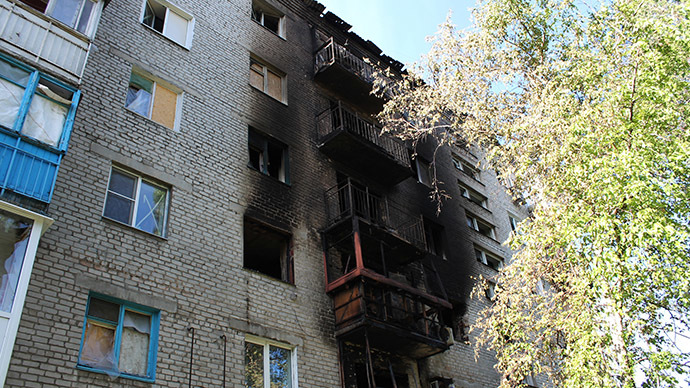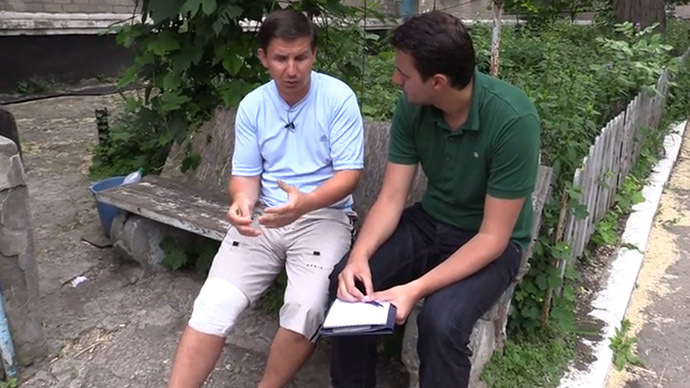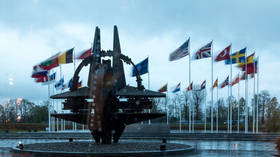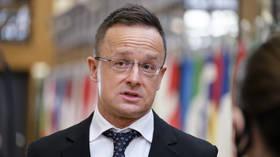‘Journo or no, when shelled panic overwhelms’: AFP contributor injured in Ukraine to RT

AFP contributor Aleksandr Gayuk, who was wounded in the leg in Eastern Ukraine, told RT that however professional you may be, when you get caught in shelling, the panic is overwhelming, but the ordeal hasn’t cooled his enthusiasm for his work.
Gayuk was hit in the leg by a shell fragment as he was running
for cover Sunday. He says he was lucky he suffered no permanent
damage. “Just a couple more millimeters and there would be
nothing left of my knee,” he said as he sat next to RT’s
Ilya Petrenko, his bandaged leg carefully stretched.
Ilya asked him what it was like to be under fire. “It is
scary, really. You may feel like a professional, but the moment
you get caught under fire panic overcomes you as you try to
decide what to do next. It takes several seconds to realize that
you have to dash left, or right, or duck behind cover,”
Gayuk said.
One of his thoughts, Aleksandr says, was about keeping his camera
safe: “At the same time I thought about my expensive camera.
I tried to run in such a way as to survive myself, but also not
to smash the camera.”
The fragment hit Aleksandr as he was running from cover to cover.
“As I started to run after the first shell hit, the second
one exploded closer to me. A fragment from that one caught up
with me.” But he kept running. “I was running on
auto-pilot, because I realized that if I stand there for another
second, another fragment could hit me - and it could be my last
one.”
READ MORE: AFP contributor injured in shelling in Donetsk, Ukraine
Aleksandr managed to reach a makeshift shelter and received first
aid from the people there. One of them tried to call an
ambulance, but the crew said they wouldn’t go to an area that was
under fire. The photo reporter had to walk some more until he
reached the nearest road and got a lift to the hospital with a
random driver.
Aleksandr admits he was “scared to death,” but says he
will not back down from his job.
“I was in shock at first,” he says. “But now I am
fine, I can photograph and film, and I will keep doing it, keep
working at the frontline.”
Sunday was not the first time Aleksandr had shells exploding
right next to him. It had happened once before, but that time he
escaped unharmed. He believes this will not be the last time,
either.

When asked which side he thought the shelling came from, he said
it was impossible to tell.
“You can tell the direction… but here different forces are
located rather close to each other. No one can see exactly who
fired the shells.”
And it is not just those on the receiving end, Aleksandr says.
With weapon ranges of about 15 kilometers, those raining shells
down on Donetsk cannot see who they are hitting, either.
“They kill people, but they do not know who they are
killing,” Aleksandr says. “This is the paradox of this
war. A year-and-a-half-old kid is playing in the sandbox – and a
shell fragment can kill him. Or a woman is coming back from a
shop – a minute later she can end up without her head. They are
not fighters; they do not wear St. George ribbons; they are not
demanding a referendum. They just live here.”
READ MORE: In the line of fire: Journalists killed and abducted in Eastern Ukraine
At a conference in Vienna, the UN dubbed Ukraine one of the most
dangerous countries for journalists, putting it on a par with
Iraq, Afghanistan and Syria. When asked whether he agrees with
such an assessment, Aleksandr cites other journalists he has
spoken to: “I talked to my colleagues from Europe who had
been to Syria and other warzones. They told me they were shocked
by how dangerous it is to work here. Here, things are much more
complicated.”
He says in Ukraine you cannot always tell where the frontline is:
“There [in other warzones] you can see: here is the
frontline, here is the rear, and that is where the war is going
on. Here, the frontline can be situated in any of Donetsk’s
districts. You don’t know where you can get killed. You don’t
know when to put on a flak vest. This is in part because mortars
and artillery are the most-often used weapons here. You can put
on a bullet-proof vest and a helmet and be safe from a person who
decides to shoot you with a Kalashnikov. But if 122-millimeter
shell fragments are coming your way, just any flak vest cannot
save your life.”
Aleksandr points to his wounded knee and says: “There are no
flak vests covering your knees, for example. You can easily end
up without a leg or your head or wherever it hits you.”
Meanwhile, OSCE observers say dozens of heavy weapons have been
taken from the storage lots that they are supposed to remain in
under the Minsk peace roadmap. Monday’s daily report by the
monitoring mission says the Ukrainian military has removed some
20 artillery pieces, while anti-government fighters have taken
away 12. Observers also say the Ukrainian army did not let them
near one of its storage places.












